Centauri Dreams
Imagining and Planning Interstellar Exploration
Pulsar Navigation: Mining Our Datasets
Science fiction dealt with interstellar navigation issues early on. In fact, Clément Vidal’s new paper, discussed in these pages yesterday, notes a George O. Smith story called “Troubled Star,” which originally ran in a 1953 issue of Startling Stories and later emerged as a novel (Avalon Books, 1957). Smith is best remembered for a series of stories collected under the title Venus Equilateral, but the otherwise forgettable Troubled Star taps into the idea of using an interstellar navigation network, one that might include our own Sun.
The story includes this bit of dialogue between human and the alien being Scyth Radnor, the latter explaining why his civilization would like to turn our Sun into a variable star:
“We use the three-day variable to denote the galactic travel lanes. Very effective. We use the longer variable types for other things – dangerous places like cloud-drifts, or a dead sun that might be as deadly to a spacecraft as a shoal is to a seagoing vessel. It’s all very logical.”
“…you’re going to make a variable star out of Sol, just for this?”
Well, why not, in Scyth Radnor’s view — after all, what’s one star in a galaxy-spanning navigation network? From our point of view, distant pulsars make for less local disruption, and as we saw yesterday, navigation by X-ray millisecond pulsars is already undergoing testing.
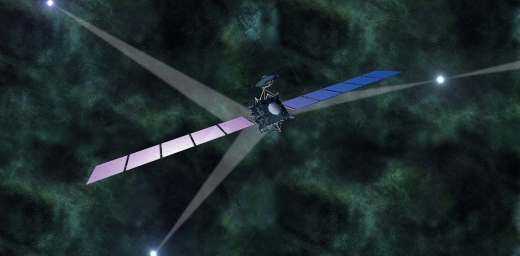
Image: Our early experiments, described yesterday, explore how we might use millisecond X-ray pulsars (MSPs) to provide autonomous spacecraft navigation. Credit: Astrowatch.net.
Visualizing a Pulsar Navigation Network
Using millisecond X-ray pulsars (MSPs) for galaxy-spanning navigation raises more than a few questions, especially when we try to predict what an artificial pulsar navigation system might look like to outside observers. If we are willing to posit for a moment a Kardashev II-level civilization moving between stars at relativistic velocities, then we would make as one of our predictions that such a system would be suitable for navigation at such speeds. In following the predictive model of Vidal’s paper, we would then check through our voluminous pulsar data to see how such a prediction fares. The answer, in other words, is in our datasets, and demands analyzing the viability of pulsar navigation at high fractions of c.
To my knowledge, no one has yet done this, making Vidal’s paper a spur to such research. The key here is to make predictions to see which can be falsified. But a quick recap for those just coming in on the discussion. What Vidal (Universiteit Brussel, Belgium) offers is an examination of millisecond X-ray pulsars as navigational aids, of the sort we’re already beginning to exploit through experiments via NASA, Chinese efforts and studies at the European Space Agency.
Specifically, the idea here is to develop a methodology for studying cases where astrophysical phenomena may have as one proposed explanation an extraterrestrial technology. Vidal also wonders whether we might find SETI implications even if a fully natural network like this were simply put to work by civilizations more advanced than our own, using it as we might wish to do.
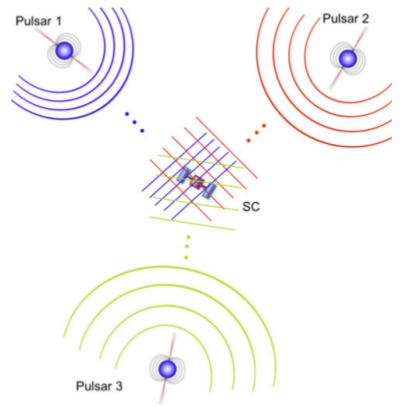
Image: From Vidal’s paper, Fig. 4. Caption: A three-dimensional position fix can be obtained by observing at least three pulsars. Given three well-chosen pulsars, there is only one unique set of pulses that solve the location of the spacecraft (SC). Figure adapted from Sheikh (2005, 200).
Vidal is hoping to make predictions that are testable against our accumulating data to assess the likelihood of natural and artificial explanations, with pulsars as the case in point. The paper examines the kinds of predictions we would want to weigh against available data in a program the author calls SETI-XNAV. Whatever conclusions it reaches, such a program would improve our knowledge of pulsars themselves and our techniques at using them, possibly leading to our augmenting existing resources like the Deep Space Network with XNAV capabilities.
The author’s approach assumes that subjecting decades of data to analysis will teach us much about pulsar navigation as well as future SETI efforts:
Scientifically, SETI-XNAV is a concrete ETI hypothesis to test. The data is here, the timing and navigation functionalities are here. Historically, the suspicion of artificial canals on Mars triggered space missions to Mars and developed knowledge about Mars. Similarly, the project to try to decipher any potentially meaningful information in pulsar’s signals… could lead to the development of tools and methods that can be used for any future candidate signal.
That, of course, would augment the SETI effort as we expand into Dysonian SETI and the examination of possible engineering as the explanation for enigimatic astrophysical observations. If we assume a galaxy with a completely natural navigational system of this power, then we can imagine other civilizations putting it to use. Thus MSPs are likely to be standards in timekeeping and navigation for all putative civilizations in the Milky Way.
The Landscape of Prediction
Millisecond pulsars account for perhaps 10% of known pulsars, and as I mentioned yesterday, they appear to be distributed isotropically in the galaxy, a contrast to the rest of the pulsar population, which appears more concentrated in the galactic disk. MSPs offer numerous advantages from a navigational standpoint given that, according to Vidal, they are more than 100,000 times more stable than normal pulsars. Timing noise, an irregularity found in normal pulsars, and so-called ‘glitches’ (abrupt changes in rotation speed) are less frequent in MSPs. The latter are also associated with lower velocities than the other 90 percent of the pulsar population.
From the standpoint of artificiality, Vidal breaks the possibility terrain down seven ways (this is drawn from the paper’s Figure 1):
0 – Natural. All pulsars are natural. We are just lucky they provide stable clocks and an accurate navigation system
1 – Pulsars as standards. All pulsars are natural, but ETIs use them for timing, positioning and navigation purposes. Communication is galacto-tagged and time-stamped with a pulsar standard
2 – Natural and alterable. Some ETIs have the technology and capability to jam, spoof or interfere with a natural pulsar positioning system
3 – Artificial MSXP for navigation. Only a few millisecond X-ray pulsars have been modified by ETI for galactic navigation and timing purposes
4 – Artificial MSXP for navigation and communication. Only a few MSXPs have been modified by ETI, for navigation, timing and communication purposes
5 – Artificial pulsars. All pulsars are artificial. ETI build them, even the new ones, by intentionally triggering supernovas
6 – Artificial pulsars for us. All pulsars are artificial. ETI build them and they are currently sending us Earth-specific messages
The point here is telling for Dysonian SETI in general. We have established pulsar formation models that seem to work. To establish a program of XNAV-SETI, examining our storehouse of pulsar data, we do not need to challenge it.
But as we have learned more about pulsars over the years, we have learned that there is no unified pulsar model that explains the variety we have seen among this population. We can look toward understanding what MSPs are doing by asking what new hypotheses explain this rich set of observations.
The wide range of Vidal’s seven scenarios makes his case straightforward: “…we do not necessarily need to contradict existing pulsar models to entertain the possibility that ETI might be involved.” The issue then becomes, Vidal adds, to make and validate new predictions.
Emergent Questions
Yesterday I mentioned a recent paper examining radio pulsars in a SETI context. It was Chennamangalam, Siemion, Lorimer & Werthimer, “Jumping the energetics queue: Modulation of pulsar signals by extraterrestrial civilizations,” New Astronomy Volume 34, January 2015, pp. 245-249 (abstract). The paper examines the possibility of pulsars as ‘naturally occurring radio transmitters’ onto whose emissions information has been encoded. Vidal likewise thinks about millisecond X-ray pulsars in the context of possible information content, noting that Carl Sagan pondered studying pulsar amplitude and polarization nulls as far back as 1973.
It might be argued that communications signals would likely be compressed, making decoding extremely problematic, but Vidal’s point here is that navigational systems differ in fundamental ways from communications systems. Navigational signals should be more regular and easier to process than highly modulated signals with communications intent. If we are looking for content grafted onto the navigational signal, we can bring to bear the entire SETI toolkit, perhaps examining pulsar data in light of delay-tolerant networking and discontinuities in connectivity.
We move back into the area of predictions. World clocks on Earth are regularly re-synchronized, just as the time on global positioning satellites is synchronized through methods Vidal discusses, using a control segment that communicates with a satellite segment. Can we observe anything like this in our pulsar data? The author frames the matter this way:
The fastest and most stable MSPs might constitute such a control segment, to which the other pulsars would synchronize. Concretely, we could look for time correction signals broadcasts (that exist in GNSSs [Global Navigation Satellite Systems]), or synchronization waves. For example, synchronization might occur first on pulsars nearest the putative control segment and then diffuse to further away pulsars. This could be investigated via rare MSP glitches, or other remarkable features, such as giant pulses in MSPs.
Synchronization between MSPs would be evidence for a distributed solution on an interstellar level.
Other questions to explore: Do we find that MSPs further away from the galactic plane are more powerful than those closer in, potentially designed for low-density regions of the galaxy? Is MSP distribution random or does it show a pattern fitting the needs of galactic navigation? Estimates of the number of MSPs needed to navigate the entire galaxy might be contrasted with astrophysical predictions of the MSP population, currently estimated to be between 30,000 and 200,000. This one, of course, is tricky: We can only derive a theoretical lower boundary.
How MSPs form and evolve is fruitful ground for inquiry, given that some scientists have argued that the most commonly cited scenario for MSP evolution does not produce the X-ray MSP population we see. It is hard to see how an MSP in a non-binary system can maintain its spin without degrading over time, making the single MSP ground for study. Thus another round of prediction is possible. Single MSPs, those without an energy source, may simply be non-working parts of the network. Do we see redundancy between single and binary MSP coverage, given that binary MSPs are likely more reliable over long time periods?
What Vidal calls SETI-XNAV makes a significant departure from conventional SETI in the sense that it is not localized around a single star, but rather involves a search for a distributed signal that exists in the form of a navigation system, one either established by extraterrestrial engineering or simply relying on a natural phenomenon to pursue its own activities. That we can begin to use millisecond X-ray pulsars as navigation standards implies that more advanced civilizations have done so. Thus SETI-XNAV as constructed in this paper intends to survey the testable predictions against which we can run our expanding dataset on pulsars.
…all pulsars could be perfectly natural, but we can reasonably expect that civilizations in the galaxy will use them as standards… By studying and using XNAV, we are also getting ready to receive and send messages to ETI in a galactically meaningful way. From now on, we might be able to decipher the first level of timing and positioning metadata in any galactic communication.
But I would also emphasize that making testable predictions about pulsar navigation also exercises our skills at analyzing future astrophysical data that may prove enigmatic. That, in and of itself, is a useful contribution in this era of KIC 8462852 and ‘Oumuamua.
The paper is “Pulsar positioning system: a quest for evidence of extraterrestrial engineering,” published online in the International Journal of Astrobiology 23 November 2017 (abstract / preprint). See also Vidal, “Millisecond Pulsars as Standards: Timing, Positioning and Communication,” Proceedings IAU Symposium No. 337, edited by P. Weltevrede, B. B. P. Perera, L. Levin Preston, and S. Sanidas. Jodrell Bank Observatory, UK (2017). Preprint available.

Pulsar Navigation: Exploring an ETI Hypothesis
Pulsar navigation may be our solution to getting around not just the Solar System but the regions beyond it. For millisecond pulsars, a subset of the pulsar population, seem to offer positioning, navigation, and timing data, enabling autonomous navigation for any spacecraft that can properly receive and interpret their signals. The news that NASA’s SEXTANT experiment has proven successful gives weight to the idea. Station Explorer for X-ray Timing and Navigation Technology is all about developing X-ray navigation for future interplanetary travel.
At work here is NICER — Neutron-star Interior Composition Explorer — which has been deployed on the International Space Station since June as an external payload. NICER deploys 52 X-ray telescopes and silicon-drift detectors in the detection of the pulsing neutron stars called pulsars. Radiation from their magnetic fields sweeps the sky in ways that can be useful. A recent demonstration used four millisecond pulsar targets — J0218+4232, B1821-24, J0030+0451, and J0437-4715 — to track NICER within a 10-mile radius as it orbited the Earth.
X-ray Pulsar Navigation (XNAV) has become an active area of research, pursued not just at NASA but by Chinese satellite testing and by conceptual studies at the European Space Agency. Having barely left our own planet, we are far ahead of ourselves to talk about a galactic positioning system for future spacecraft, but there is reason to believe that the principles of pulsar navigation can be extended to make accurate deep space navigation a reality.
Pulsars as Navigational Matrix
The SEXTANT experiment dovetails with a new paper from Clément Vidal (Universiteit Brussel, Belgium), whose work falls into the broader context of recent studies of unusual astrophysical phenomena. The author of the ambitious The Beginning and the End (Springer, 2014), Vidal’s work has been the subject of several articles in these pages (see, for example, A Test Case for Astroengineering and related entries accessible in the archives). In this era of the enigmatic KIC 8462852 and the interstellar object ‘Oumuamua, we have begun to ask how to address possible extraterrestrial engineering within the confines of rigorous astrophysics.
Millisecond pulsars may offer a way to examine such questions, but it is important to point out at the outset the Vidal is not arguing that this type of pulsar is evidence of extraterrestrial engineering. What he is trying to do is ask a question with broader implications. How do we study unusual astrophysical phenomena in ways that include an extraterrestrial hypothesis? How, in fact, do we conclude when that hypothesis is remotely relevant? And are there ways to make observable and refutable predictions that would help us distinguish purely astrophysical phenomena from what Vidal calls ‘astrobiological’ phenomena that imply intelligence?
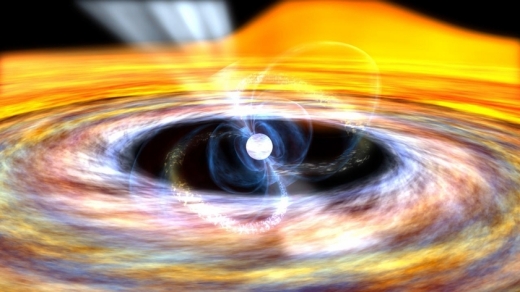
Image: An artist’s impression of an accreting X-ray millisecond pulsar. The inflowing material from the companion star forms a disk around the neutron star which is truncated at the edge of the pulsar magnetosphere. Credit & copyright: NASA / Goddard Space Flight Center / Dana Berry.
We’ve seen in the analysis of KIC 8462852 how many hypotheses have been put forward to explain that star’s unusual light curves, with more and more attention now being paid to a natural explanation involving dust in the system. Vidal’s lengthy paper examines the question of millisecond pulsars being useful for navigation, as with our own civilization’s global navigation satellite systems, like the Global Positioning System (GPS) or the Russian GLONASS (GLObal NAvigation Satellite System).
If we can derive a navigational methodology out of astronomical objects found throughout the galaxy, it seems reasonable to believe that more advanced civilizations would have deduced the same facts and might be using a pulsar positioning system (PPS) in their own activities. Pulsar navigation might thus have SETI potential — might some future SETI candidate signal contain timing and positioning metadata? Might some astrophysical phenomena like pulsars be modified by advanced cultures for use as beacons?
And if we push the issue to its conclusion, is it conceivable that what we see as a pulsar navigation capability is the result of deliberate engineering on a vast scale, the sort of thing we’ve imagined the builders of Dyson spheres and Kardashev Type II civilizations engaging in? Vidal does not argue that this is the case, but calls instead for using pulsar navigation as a way into what he calls SETI-XNAV, a program of research that would use existing and future astronomical data to examine millisecond pulsars in the context of testable predictions.
Vidal sees this as a way to “join pulsar astrophysics, astrobiology and navigation science,” one whose benefits would include developing new methods to design more efficient global navigation satellite systems here on Earth even as we explore how to refine our early XNAV experiments. Not incidentally, we would also be examining our methods when, as seems inevitable, we are confronted with another case of an astrophysical object that raises questions about possible artificial origins.
Implications of Galactic Navigation
An ETI hypothesis has played around the idea of pulsars from the beginning, with a brief interest in extraterrestrial technologies leading to the objects being nicknamed ‘LGM stars,’ for ‘Little Green Men.’ But as Vidal explains, models explaining pulsar behavior are available that invoke nothing but natural processes. It’s fascinating to see that Italian astrophysicist Franco Pacini predicted pulsars based on his studies of neutron stars some months before their discovery was announced by Jocelyn Bell and Anthony Hewish in 1967. Vidal goes on to say:
Pacini’s and [Thomas] Gold’s models were the very first modeling attempts. Pulsar astronomy has immensely progressed since then, and pulsars display a phenomenology that requires much more advanced models (see the section Pulsar behavior). There is no single unified pulsar model that can explain all the variety of observations… nobody predicted that our Galaxy would host some pulsars with pulsations rivaling atomic clocks in stability, or that their distribution would make them useful for an out-of-the-spiral galactic navigation system.
It’s a system we’ve begun to explore because of the need for autonomous navigation, in which a spacecraft is capable of navigating without recourse to resources on Earth or in nearby space. Homing in on millisecond pulsars (MSPs) as a unique subset of the broader population of pulsars, Vidal asks what observable predictions we might make that could help us distinguish natural phenomena from artificial. Galactic distribution turns out to be one such marker.
The distribution of MSPs is isotropic, while normal pulsars appear to be concentrated in the galactic plane. Because they are formed in binary systems, this distribution of MSPs causes us to ask why there would be more binary star systems outside the galactic disk than in it.
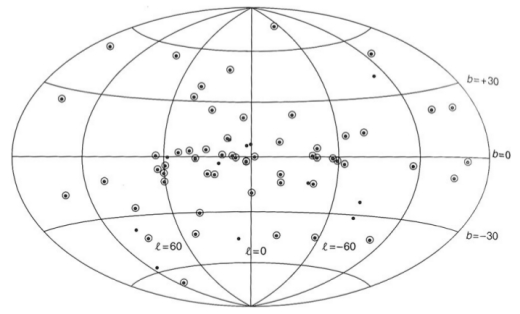
Image: Figure 7 from the Vidal paper. Caption: The distribution of MSPs in Galactic coordinates, excluding those in globular clusters. Binary MSPs are shown by open circles. From Lyne & Graham-Smith (2012, 116). Credit: Clément Vidal.
Bear in mind that while pulsar navigation became an early topic, proposed as far back as 1974 by JPL’s George Downs, it was the proposal to use X-ray pulsars instead of radio pulsars (Chester and Butman, 1981) that demonstrated both improved accuracy and the ability to use the kind of small detectors that would be feasible for inclusion in a spacecraft payload.
The discovery of X-ray millisecond pulsars shortly thereafter illustrated the difference between ‘normal’ pulsars and MSPs (for more on this, see Duncan Lorimer’s “Binary and Millisecond Pulsars,” Living Reviews in Relativity December 2008, 11:8; abstract here). Although there is much to say about this issue, for now keep in mind the key difference noted above: MSPs accrete matter from a companion. They are generally found in binary systems.
Now we enter the realm of prediction. If there is a case to be made for MSPs as evidence of engineering, we would expect them to be distributed in ways that would appear non-random. We would expect few redundancies in their coverage areas, and in terms of their numbers, there should be enough for galactic navigation but not necessarily more. Moreover, we would expect artificial navigation sources like X-ray millisecond pulsars to beam preferentially in the galactic plane. If we do not find these things, the astrophysical model is supported.
What emerges in this paper is a series of such predictions that can be used to examine our growing data about pulsar, and in particular MSP, behavior. The data offer a rich enough hunting ground that we can look at such things as MSPs in globular clusters as opposed to elsewhere in the galaxy. We find that about half of MSPs appear in globular clusters, a fact that supports an astrophysical explanation, since stellar encounters are likely in such quarters and thus the formation of the binary star systems that produce MSPs in the first place is to be expected.
If MSPs are engineered objects, we would expect different properties between cluster MSPs and those in the disk. We should examine such questions as beaming direction, which an astrophysical explanation would find to be random. We would study as well whether pulsar beaming overlaps with other pulsar beaming within such clusters. Such a study under the SETI-XNAV rubric might help us uncover new binary MSPs, Vidal asserts, by modeling the coverage areas of MSPs and searching in places where coverage would be non-existent. The prediction would then be that we should find an MSP filling in the putative coverage gap.
Vidal’s paper offers numerous areas for such investigation. SETI-XNAV, he writes:
…draws on pulsar astronomy, as well as navigation and positioning science to make SETI predictions. This concrete project is grounded in a universal problem and needs: navigation. Decades of pulsar empirical data is available and I have proposed nine lines of inquiry to begin the endeavor… These include predictions regarding the spatial and power distribution of pulsars in the galaxy; their population; their evolutionary tracks; possible synchronization between pulsars; testing the navigability near the speed of light; decoding galactic coordinates; testing various directed panspermia hypotheses; as well as decoding metadata or more information in pulsar’s pulses.
My interest is in seeing how Vidal makes the distinction between astrophysical and astrobiological — in other words, as with KIC 8462852 and the interstellar object ‘Oumuamua, are we making progress as we begin to investigate under what some have called the ‘Dysonian’ SETI paradigm? That approach takes its name from the postulated Dyson spheres that have been the subject of early work and continue to be studied through projects like the Glimpsing Heat from Alien Technologies (G-HAT) program at Penn State (see Jason Wright’s Glimpsing Heat from Alien Technologies for more). These issues will grow in relevance as our observational tools hasten the pace of discovery.
More thoughts on all this in my next post. The paper is Vidal, “Pulsar positioning system: a quest for evidence of extraterrestrial engineering,” published online in the International Journal of Astrobiology 23 November 2017 (abstract / preprint). Also of interest: Chennamangalam, Siemion, Lorimer & Werthimer, “Jumping the energetics queue: Modulation of pulsar signals by extraterrestrial civilizations,” New Astronomy Volume 34, January 2015, pp. 245-249 (abstract).

SETI and Astrobiology: Toward a Unified Strategy
Will we recognize life if and when we find it elsewhere in the cosmos? It’s a challenging question because we have only the example of life on our own world to work with. Fred Hoyle’s The Black Cloud raised the question back in 1957, a great memory for me because this was one of the earlier science fiction novels that I ever read. I remember sitting there with it in my 5th grade class in St. Louis, Missouri, having been loaned the paperback that had begun to circulate among my fellow students. I was mesmerized by the account of life as I had never imagined it.
Hoyle, you’ll recall, creates a vast cloud of gas and dust that turns out to be a kind of super-organism, and I leave the rest of this tale to those fortunate enough to be coming to it for the first time. But we’ve had the same conversation about Robert Forward’s ‘Cheela’ recently, living as they do on the surface of a neutron star. The question is one Jacob Bronowski circulated widely through his televised series The Ascent of Man back in the 1970s:
…it does not at all follow that the evolutionary path which life (if we discover it) took elsewhere must resemble ours. It does not even follow that we shall recognise it as life — or that it will recognise us.

Let’s talk about all this in terms of astrobiology and SETI. For many of us, the two have a seamless character. Detect a radio beacon from another civilization and you have, ipso facto, detected life or, at least, a technological product that life has produced. SETI then is clearly an aspect of astrobiology, just as the discipline also takes in lichen growing around a pond, or aquatic creatures of high intelligence but no technologies. With both SETI and our search for non-technological life, we’re hoping to detect living things that evolved elsewhere.
Thus I find myself in agreement with a new white paper that has been submitted to The National Academies of Sciences, Engineering and Medicine as part of the process of carrying out upcoming decadal surveys in astronomy, astrophysics and planetary science. The authors are major figures from the SETI community: Jill Tarter and John Rummel (SETI Institute); Andrew Siemion (Berkeley SETI Research Center and Breakthrough Listen); Martin Rees (Breakthrough Listen, among so many other things); Claudio Maccone (chair, IAA SETI Permanent Committee); and Greg Hellbourg (International SETI Collaboration).
Titled “Three Versions of the Third Law: Technosignatures and Astrobiology,” the document makes the case that there has arisen an artificial distinction between astrobiology and SETI, with the former deemed acceptable for funding in ways that SETI has often not been, given the controversies in its history. As evidence, take the current 2015 NASA Astrobiology Strategy document, which baldly states: “While traditional Search for Extraterrestrial Intelligence (SETI) is not part of astrobiology, and is currently well-funded by private sources, it is reasonable for astrobiology to maintain strong ties to the SETI community.”
Strong ties are good, surely, but the distinction is artificial. In what sense is SETI not part of astrobiology? As the white paper notes, the Galileo flyby described by Carl Sagan and fellow authors in a 1993 paper in Nature found that a critical lifemarker (for both life itself and intelligent life) was the presence of narrow-band, pulsed, amplitude modulated radio signals. This is the kind of data rejected by the exclusion of SETI from astrobiology.
This delightful quote from the white paper nails the issue:
This is an arbitrary distinction that artificially limits the selection of appropriate tools for astrobiology to employ in the search for life beyond Earth, one that it is not supported scientifically. The science of astrobiology recognizes life as a continuum from microbes to mathematicians. It is time to remove this artificial barrier, and to re-integrate the community of all those who wish to study the origin, evolution, and distribution of life in the universe.
From microbes to mathematicians indeed!
This is more than a matter of splitting hairs in academic documents, for how we define things can play a major role in how we as a society fund our scientific investigations. Here I would urge you to read the paper, which you can find here — click on ‘View the Submitted White Papers.’
Bear in mind the imminence of further debate. A meeting on Astrobiology Science Strategy for the Search for Life in the Universe will take place from January 16-18 in Irvine, CA, with a second meeting scheduled for March 6-8, 2018 in Washington, DC to discuss these matters. A unified astrobiology/SETI strategy may yet emerge from all this.
Background is everything in this discussion. It was in 1993 that funding for NASA’s High Resolution Microwave Survey was terminated, with SETI essentially being sent into the wilderness. The National Science Foundation actually prohibited SETI funding in language that was not removed until 2000. SETI then achieved eligibility for funding in 2001, according to NASA associate administrator Ed Weiler, even as the various astrobiology roadmaps leading up to today’s strategy at times included and at other times excluded SETI.
Similarly inconsistent have been the annual NASA funding efforts known as ROSES — Research Opportunities in Earth and Space Science. The white paper goes through the history of these changes.
There is no question that SETI has at various times become a political football, which accounts for its inclusions and exclusions from the astrobiology roadmaps of past years. We need a unified strategy sans politics. Goal 7 of previous astrobiology roadmaps has been stated as: “Determine how to recognize the signatures of life on other worlds.” Searching for technosignatures is clearly one such method, leading the authors of the white paper to make their case:
It is time that we end this scientific schizophrenia. It is of course reasonable for a funding agency to elect not to fund any given proposal, but it is unscientific to exclude clearly related proposals from consideration. Historical politics or a perceived (but unverified) funding status from other sources should not enter into an estimation of the scientific value of an approach.
The title of the white paper, incidentally, is a nod to Arthur C. Clarke’s third law: “Any sufficiently advanced technology is indistinguishable from magic.” In this case, the quote is used to explore how difficult it may be to find extraterrestrial life of any kind. If intelligent, such life might build enormous structures observable by our astronomy.
Or perhaps not: Karl Schroeder has posited that advanced technologies may be indistinguishable not from magic but from nature. In other words, the future means continual advances in efficiencies “…until our machines approach the thermodynamic equilibria of their environment, and our economics is replaced by an ecology where nothing is wasted.” That’s yet another possibility for the so-called Great Silence.
We can’t know exactly where or how to look, which is why all feasible strategies have to be on the table in the search for biosignatures as well as technosignatures. The paper concludes:
There is no scientific justification for excluding SETI, or any other technosignature modality, from the suite of astrobiological investigations. Arguments based on political sensitivities or apparent access to other funding sources are inappropriate. In this white paper, we argue for a level playing field.

PicSat: Eye on Beta Pictoris
To understand why Beta Pictoris is receiving so much attention among astronomers, particularly those specializing in exoplanets, you have only to consider a few parameters. This is a young star, perhaps 25 million years old, one with a well observed circumstellar disk, the first actually imaged around another star. We not only have a large gas giant in orbit here, but also evidence of cometary activity as seen in spectral data. ? Pic is also relatively nearby at 64 light years.
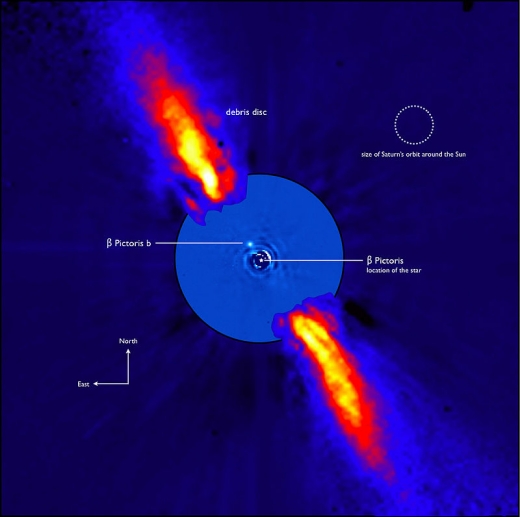
Image: This composite image represents the close environment of Beta Pictoris as seen in near infrared light. This very faint environment is revealed after a careful subtraction of the much brighter stellar halo. The outer part of the image shows the reflected light on the dust disc, as observed in 1996 with the ADONIS instrument on ESO’s 3.6 m telescope; the inner part is the innermost part of the system, as seen at 3.6 microns with NACO on the Very Large Telescope. The newly detected source is more than 1000 times fainter than Beta Pictoris and aligned with the disc. Both parts of the image were obtained on ESO telescopes equipped with adaptive optics. Credit: ESO/A.-M. Lagrange et al.
Consider this star, then, a conveniently close laboratory for the study of how stellar systems form. ? Pic b, about seven times as massive as Jupiter, was discovered in 2009 by a French team led by Anne-Marie Lagrange (CNRS/Université Grenoble Alpes). The planet orbits at 1.5 billion kilometers, roughly the distance of Saturn from our Sun, but there is also the possibility of other planets now in formation within the debris disk. Indeed, the observed structure of planetesimal belts here is a possible indication of smaller planets we have not yet observed.
While ? Pic b was discovered by direct imaging, there are interesting transit possibilities that are now being explored by scientists at the Paris Observatory and the Centre National De La Recherche Scientifique (CNRS). With launch scheduled for tomorrow, PicSat is a nanosatellite built on a CubeSat platform, one containing a 5 cm telescope destined for the study of ? Pic. PicSat will use no more than 5 watts of power in the attempt to view a transit of ? Pic b.
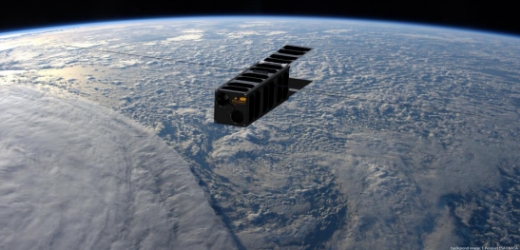
Image: An artist’s impression of PicSat in orbit around the Earth. Credit and copyright: T. Pesquet ESA / NASA – LESIA / Observatoire de Paris.
We don’t have a firm idea of exactly when the transit will occur, but scientists with the project peg any time between now and the summer of this year. A transit here would last only a few hours, but it would give us information about the size of the planet, the extent of its atmosphere and its chemical composition. The beginning of a transit will trigger an alert to the 3.6 meter telescope at the European Southern Observatory’s La Silla site, where the HARPS (High Accuracy Radial velocity Planet Searcher) spectrograph can be used to study the event.
Keeping a continuous eye on ? Pic to spot the beginning of the transit is thus an imperative. Transits are expected to occur only every 18 years, and indeed PicSat was designed and constructed in just three short years. Modular methodologies to the rescue as we are reminded once again that simple resources like CubeSats are capable of world-class science.
Launch is scheduled for 12 January at 0358 UTC (2258 EST) aboard an Indian PSLV launcher, with the satellite inserted into a polar orbit at an altitude of 505 kilometers, a tandem launch that will include some thirty other satellites. While the satellite will be operated from Meudon in France, a facility of the Paris Observatory, PicSat uses radio amateur bands for communication.
Citizen scientists therefore take note: The PicSat team is opening the door for radio amateurs worldwise to collaborate in tracking the satellite, receiving data and relaying them to the PicSat database over the Internet. Have a look at the PicSat website for information on how to register to become part of this ad hoc radio network and follow PicSat updates. The site has been down this morning, presumably because of last minute updates, but keep checking.
Pssst everyone. It is PicSat, from the inside on top of the #PSLVC40 launcher, whispering, must disturb my co-travellers. It is 9h28m AM here in Sriharikota, 4h58m AM in Paris. That means 24 hours to ignition … & counting 23:59:59, 23:59:58, 23:59:27 …. sooo excited! #CubeSat pic.twitter.com/dnTqJPZ3EY
— PicSat (@IamPicSat) January 11, 2018
Achieving great things with small packages is becoming part of our culture, and we can wish French space agency CNES and PicSat a safe launch as it begins its one year mission. The launch will be covered live here and you can keep up with PicSat events at https://twitter.com/IamPicSat, or check out its YouTube channel.

Exploring Origins of a Fast Radio Burst
Fast Radio Bursts (FRBs) continue to intrigue us given their energy levels. You may recall FRB 121102, which was revealed at a press conference almost exactly one year ago to be located in a radio galaxy some 3 billion light years away. This is a repeating FRB (the only repeating source yet found), making its study an imperative as we try to characterize the phenomenon.
With data from Arecibo, the Very Large Array and the European VLBI network, astronomers determined its position to within a fraction of an arcsecond, where a source of weak radio emission is also traced. Today, drawing on new observations from Arecibo and the Green Bank instrument in West Virginia, we learn something about the source of these bursts.
The energies we are talking about are obviously titanic. Given the distance between the source and us, researchers have calculated that each burst throws as much energy in a single millisecond as our Sun releases in an entire day. And as we learn in the latest issue of Nature, an international team has been able to show that the bursts from FRB 121102 are highly polarized, allowing insights into the environment from which it sprang. The analysis was revealed at a meeting of the American Astronomical Society in Washington, D.C.
In play here is a phenomenon known as Faraday rotation, which is the ‘twisting’ that happens to polarized radio waves as they pass through a magnetic field. And what stands out in these findings is the apparent strength of the magnetic field involved, for the Faraday rotation is extreme, among the largest ever measured in a radio source. The implication: The bursts are evidently moving through an exceedingly powerful magnetic field in a dense plasma.
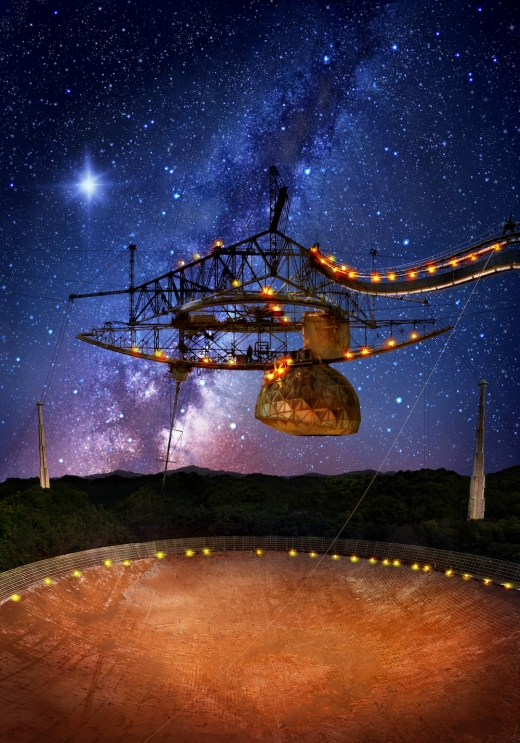
Image: The 305-metre Arecibo telescope, in Puerto Rico, and its suspended support platform of radio receivers is shown amid a starry night. A flash from the Fast Radio Burst source FRB 121102 is seen: originating beyond the Milky Way, from deep in extragalactic space. Credit: Image design: Danielle Futselaar – Photo usage: Brian P. Irwin / Dennis van de Water / Shutterstock.com.
We now move into the realm of speculation. Is FRB 121102 situated close to a massive black hole at the center of its host galaxy? That would correspond to some degree with the magnetized plasmas that have been observed in the Milky Way, associated with its own supermassive black hole. But there are other possibilities, as Arecibo staff astronomer Andrew Seymour comments, referring to the FRB observations at higher radio frequencies than before:
“We developed a new observing setup at the Arecibo Observatory to do this, and our colleagues from Breakthrough Listen at the Green Bank Telescope confirmed the results with observations at even higher radio frequencies. What’s more, the polarization properties and shapes of these bursts are similar to radio emission from young, energetic neutron stars in our galaxy. This provides support to the models that the radio bursts are produced by a neutron star.”
But given that it is the only repeating FRB, is FRB 121102 somehow different from all other, non-repeating FRBs? Bursts from the former have been observed with as many as seven peaks, a more complicated structure in time and radio frequency than observed in other FRBs, which show one or occasionally two peaks in time.
“We’ve observed bursts from FRB121102 with as many as seven peaks, and the bursts peak in radio frequency as well as time,” says Laura Spitler, an astronomer at the Max-Planck-Institut für Radioastronomie, Bonn. “We are now trying to understand whether the bursts’ structure is an intrinsic feature of the process that generates the radio emission or the result of the propagation through the dense plasma local to the source.”
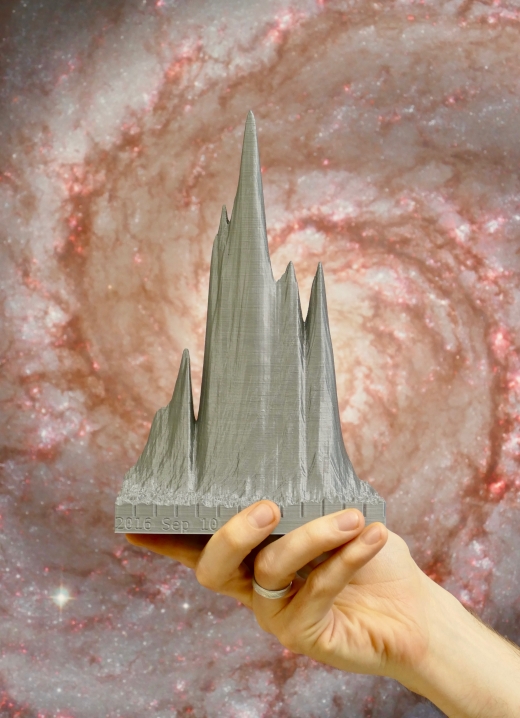
Image: One of FRB121102’s radio bursts, as detected with the Arecibo telescope. This 3D print shows how bright the burst is as a function of observed radio frequency and time. Credit: Anne Archibald (University of Amsterdam).
We may get some help in the next phase of the investigation from CHIME (Canadian Hydrogen Intensity Mapping Experiment), an interferometric radio telescope under construction in British Columbia, which should be coming online later this year. The researchers believe the instrument will be well-tuned for the detection of FRBs and for studying their degrees of polarization. McGill University’s Shriharsh Tendulkar believes CHIME will be capable of detecting “…between a few and a few dozen FRBs every day.”
Also in the cards is future observation at Green Bank, where Breakthrough Listen has allotted more time to study not just the emissions of FRB 121102, but also other FRB sources. The plan is to observe at higher frequencies, up to 12 GHz — the current Green Bank work has taken place from 4-8 GHz. Whether or not the energy of FRB 121102 drops off at higher frequency may provide additional insights into its source.
The paper is Michilli et al., “An Extreme Magneto-Ionic Environment Associated with Fast Radio Burst Source FRB121102,” Nature 11 January 2018 (abstract).

Exoplanet Prospects at Earth-based Observatories
Although I often write about upcoming space missions that will advance exoplanet research, we’re also seeing a good deal of progress in Earth-based installations. In the Atacama Desert of northern Chile, the Extremely Large Telescope is under construction, with first light planned for 2024. With 256 times the light gathering area of the Hubble instrument, the ELT is clearly going to be a factor in not just exoplanet work but our studies of numerous other astronomical phenomena, from the earliest galaxies in the cosmos to the question of dark energy.
Today we learn that the first six hexagonal segments for the ELT’s main mirror have been cast by the German company SCHOTT at their facility in Mainz, Germany. We’re just at the beginning of the process here, for the primary mirror is to be, at 39 meters, the largest ever made for an optical-infrared telescope. 798 individual segments — each 1.4 meters across and 5 centimeters thick — will go into it, working together as a single gigantic mirror.
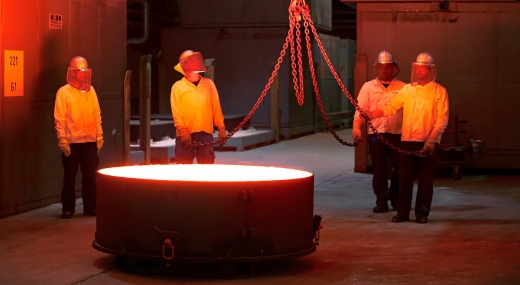
Image: The first six hexagonal segments for the main mirror of ESO’s Extremely Large Telescope (ELT) have been successfully cast by the German company SCHOTT at their facility in Mainz. These segments will form parts of the ELT’s 39-metre main mirror, which will have 798 segments in total when completed. The ELT will be the largest optical telescope in the world when it sees first light in 2024. Credit: ESO.
SCHOTT will embark on making a total of 900 segments, 798 for the primary mirror plus a spare set, with production rates when up to speed of about one segment per day. After cooling and a heat treatment sequence, the mirror segment blanks will be ground and polished to a precision of 15 nanometers, with shaping and polishing performed by the French company Safran Reosc, which will mount and test the individual segments.
Binocular Vision
Meanwhile, we also get word of two new instruments that will be mounted on the Large Binocular Telescope (LBT), located on Mount Graham in Arizona. The SHARK instruments (System for coronagraphy with High order Adaptive optics from R to K band) are designed with an explicit exoplanet purpose, to conduct direct imaging of distant worlds.
What makes the SHARK effort intriguing is that it comprises two instruments. SHARK-VIS works in visible light, SHARK-NIR in near-infrared, and on the LBT platform, the two will be operated in parallel, using the two 8.4-meter mirrors of the observatory. Built by an international consortium led by INAF, the Italian National Institute for Astrophysics, the two SHARK instruments will likewise take advantage of the observatory’s adaptive optics system, also developed by INAF. Adaptive optics corrects for distortions caused by turbulence in the Earth’s atmosphere.
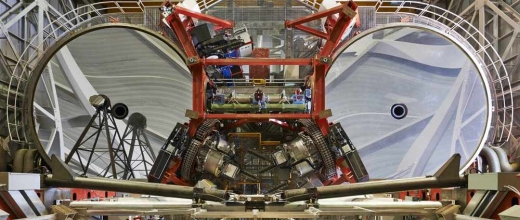
Image: Each SHARK will be installed on one side of the LBT Interferometer (LBTI), the green structure seen in the middle of the picture between the two main mirrors of LBT. Credit: SHARK Consortium/INAF.
Notice what’s happening here: The LBT, once equipped with the two SHARK add-ons, becomes the first telescope in the world that can observe exoplanets simultaneously over such a wide range of wavelengths, helping astronomers tease out planets that would otherwise be drowned in the glare of the host star. The installation, which is expected to be completed in 2019, also points the way toward the upcoming Giant Magellan Telescope, which will deploy seven 8.4-meter mirrors on the same mount instead of the LBT’s two. The GMT facility is under construction at the Las Campanas Observatory in Chile’s southern Atacama Desert.
“With SHARK, we will observe exoplanets at unprecedented angular resolution and contrast, so that we will be able to go closer to their host stars than what has been achieved up to now with direct imaging,” says Valentina D’Orazi of the INAF-Osservatorio Astronomico di Padova, instrument scientist for SHARK-NIR. “This will be possible thanks to the use of coronagraphy, which blocks out the light from the central star and highly improves the contrast in the region around the source, thus allowing us to detect the planetary objects we want to study, which otherwise would remain hidden in the star light.”
Clearly we’re moving into an era where Earth-based observatories will be capable of major advances in the exoplanet hunt, complementing the upcoming space missions that will expand the planetary census and begin the analysis of smaller exoplanet atmospheres, particularly those around red dwarf stars. Both the Extremely Large Telescope and the Giant Magellan Telescope could be completed, if current schedules are realistic, by 2025.
An Ancient Planetary System
I just noticed that the team behind PEPSI (Potsdam Echelle Polarimetric and Spectroscopic Instrument) at the Large Binocular Telescope has released three papers analyzing high spectral resolution data from the site. Because I’ve only had the chance to skim the papers, let me just quote the news release on one of these, examining the 10-billion year old system Kepler-444:
…the star “Kepler-444”, hosting five sub-terrestrial planets, was confirmed to be 10.5 billion years old, more than twice the age of our Sun and just a little bit younger than the universe as a whole. The star is also found being poor on metals. The chemical abundance pattern from the PEPSI spectrum indicates an unusually small iron-core mass fraction of 24% for its planets if star and planets were formed together. For comparison, terrestrial planets in the solar system have typically a 30% iron-core mass fraction. “This indicates that planets around metal-poor host stars are less dense than rocky planets of comparable size around more metal-rich host stars like the Sun”, explains Claude “Trey” Mack, project scientist for the Kepler-444 observation.
The paper is Mack et al., “PEPSI deep spectra. III. A chemical analysis of the ancient planet-host star Kepler-444,” in press at Astronomy &Astrophysics (preprint).


